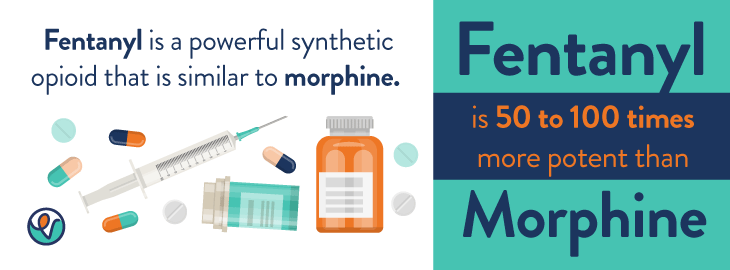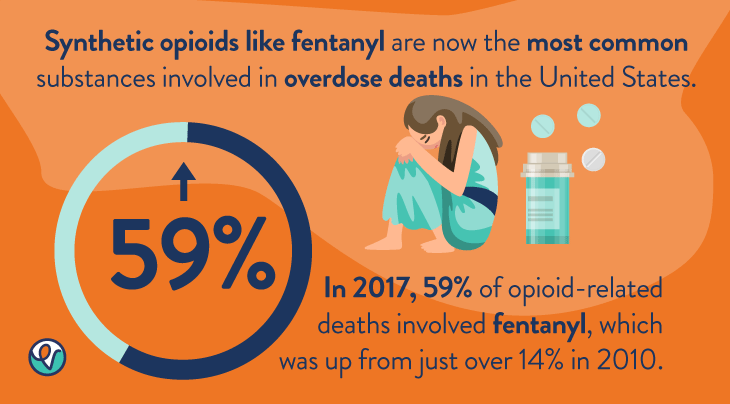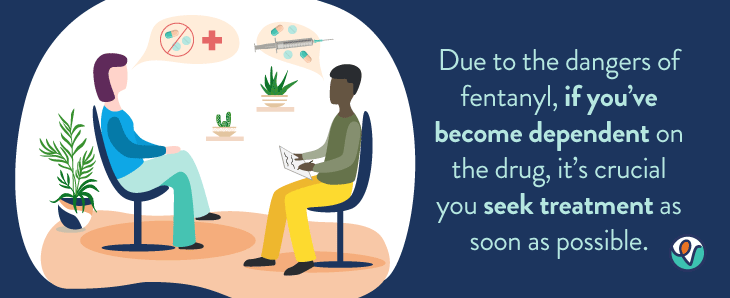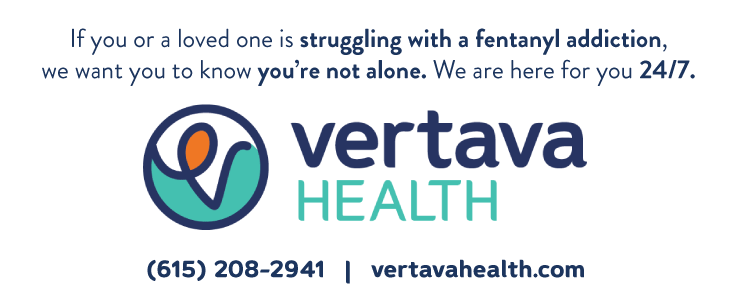An American Epidemic: Fentanyl and the Opioid Crisis
The opioid crisis has been an ongoing battle in the United States since the 1990s. Hundreds of thousands of lives have been affected in one way or another. As the years have passed, the crisis has evolved, seemingly moving from one opioid to the next. One specific opioid, known as fentanyl, has been wreaking havoc across the country over the past few years. What makes fentanyl so dangerous is that it’s often laced into other drugs and remains undetected, creating a recipe for disaster as just a small amount of fentanyl can be lethal. For the purposes of this research blog post, we’re going to examine what fentanyl is traditionally used for, how it’s misused, and its impact on the opioid crisis. 
Fentanyl: What Is It Exactly?
Like many opioids, fentanyl is intended to be used strictly for medical purposes. According to the National Institutes of Health (NIH), “Fentanyl is a powerful synthetic opioid that is similar to morphine but is 50 to 100 times more potent. It is a prescription drug that is also made and used illegally. Like morphine, it is a medicine that is typically used to treat patients with severe pain, especially after surgery. It is also sometimes used to treat patients with chronic pain who are physically tolerant to other opioids.” In a professional setting, fentanyl is typically given as a shot, patch, or lozenges (similar to a cough drop). Illegally, it can be sold as a powder, put into eye droppers or nasal sprays, or made into pills. Fentanyl is sometimes mixed with other drugs such as heroin, cocaine, methamphetamine, and MDMA. The NIH says this is “because it takes very little to produce a high with fentanyl, making it a cheaper option.” Again, this is risky when the person consuming the substance has no idea fentanyl is even involved. Synthetic opioids like fentanyl are now the most common substances involved in overdose deaths in the United States. In 2017, 59% of opioid-related deaths involved fentanyl, which was up from just over 14% in 2010. Fentanyl is usually developed in China and smuggled across borders before reaching the United States by mail or drug cartels. Since fentanyl is high in potency and easy to manufacture, it has become very profitable to make and sell.  On the streets, fentanyl may be referred to as:
On the streets, fentanyl may be referred to as:
- Dance Fever
- Jackpot
- Poison
- Goodfellas
- Great Bear
- He-Man
- Apace
How Did We Get Here?
As previously mentioned, the opioid crisis dates back to the 1990s and has since come in three waves. According to the Centers for Disease Control and Prevention (CDC), the first wave involved prescription opioids, the second wave began in 2010 with heroin, and the third started in 2013 with synthetic opioids such as fentanyl. At present, there are about 136 fatal opioid overdoses a day in the United States. [inline_cta_three]
How Does Fentanyl Make You Feel?
Similar to other opioids, fentanyl binds to the body’s opioid receptors, which are found in the portion of the brain that controls things like pain. But after continued use, the brain will become used to having fentanyl, making it that much harder to feel pleasure when you’re not ingesting it. Side effects of fentanyl include:
- Confusion
- Constipation
- Extreme happiness
- Drowsiness
- Trouble breathing
- Nausea
- Sedation
Fentanyl addiction and overdoses are also possible, and just as the numbers presented earlier indicated, they can be extremely dangerous. Signs of fentanyl addiction include:
- Being unable to stop consuming the drug despite wanting to
- Overdose
- Needing larger amounts to get high
- Fentanyl causing problems at work or school
- Negative impact on relationships with family and friends
- Strong cravings
- Withdrawal when not consuming the drug
Overdose symptoms often include slow breathing or no breathing at all. If you believe you or someone you know has overdosed on fentanyl, call 911 immediately.
What Is Fentanyl Withdrawal Like?
As mentioned earlier, misusing fentanyl and/or other opioids can result in an addiction, or what’s medically called an opioid use disorder. The NIH explains these “are characterized by compulsive drug seeking and drug use that can be difficult to control, despite harmful consequences. When someone is addicted to drugs, they continue to use them even though they cause health problems or issues at work, school, or home. An SUD [substance use disorder] can range from mild to severe.” By quitting fentanyl, you could develop withdrawal symptoms, which include:
- Problems with sleep
- Vomiting
- Diarrhea
- Fentanyl cravings
- Bone pain
- Muscle pain
- Cold flashes
- Uncontrolled leg movements
With these symptoms sometimes being very uncomfortable, some might find it necessary to seek treatment for fentanyl addiction at a professional facility where those symptoms can be managed.
Other Opioids You Should Know About
Opioids include illegal drugs such as heroin, prescription pain relievers like oxycodone (OxyContin) and hydrocodone (Zohydro ER and Vicodin), codeine, and morphine. The U.S. National Library of Medicine says opioids can cause side effects such as drowsiness, mental fog, nausea, and constipation. Opioids can also cause slowed breathing, which can lead to overdose deaths. If you or someone you know has overdosed on an opioid, call 911 immediately. In general, signs of an opioid overdose, including a fentanyl overdose, include:
- Pale face
- Vomiting or gurgling noises
- Fingernails or lips have turned a blue or purple color
- Unable to speak or wake up
- Heartbeat has slowed or stopped
- Breathing has slowed or stopped
Opioid Misuse in the United States
As we discussed earlier, opioid misuse is a major problem in the United States. The U.S. National Library of Medicine describes misuse as “taking too much medicine, taking someone else’s medicine, taking it in a different way than you are supposed to, or taking the medicine to get high.” The numbers indicate this is an ongoing issue. According to the U.S. Department of Health and Human Services (HHS), more than 760,000 people have died since 1999 from a drug overdose. In 2018, two out of every three fatal drug overdoses involved an opioid. According to that same HHS report, in 2019, 10.1 million people ages 12 and older misused opioids. That includes 9.7 million misusing prescription opioids and 745,000 consuming heroin. That same year, there were a reported near-50,000 fatal opioid-involved overdoses in the United States. If you are prescribed an opioid, make sure to follow your doctor’s orders and raise any concerns or questions you may have. Misusing opioids may not only affect your physical and mental health, but you can also find yourself in trouble with the law. The United States Drug Enforcement Administration (DEA) says opioids are controlled substances that vary from Schedule I to Schedule V, depending on their medical usefulness, misuse potential, safety, and drug dependence profile. Fentanyl is a Schedule II controlled substance, which means it has high potential for misuse but currently has medical use. However, the DEA says Schedule I narcotics, like heroin, have no medical use in the U.S. and are illegal to distribute, purchase, or use outside of medical research. [middle-callout]
How Medication-Assisted Treatment Can Help With Fentanyl Addiction
Medication-assisted treatment (MAT) is used to treat substance use disorders to help sustain recovery and prevent overdose. According to the Substance Abuse and Mental Health Services Administration (SAMHSA), “Medication-assisted treatment (MAT) is the use of medications, in combination with counseling and behavioral therapies, to provide a ‘whole-patient’ approach to the treatment of substance use disorders. Medications used in MAT are approved by the Food and Drug Administration (FDA), and MAT programs are clinically driven and tailored to meet each patient’s needs.” The medication can help normalize brain chemistry, block the euphoric (extremely pleasurable) effects of opioids, relieve opioid cravings, and normalize body functions without the negative and euphoric effects of the opioid. SAMHSA also says MAT has proved to be clinically effective and provides a more personalized treatment program. MAT can help:
- Keep people in treatment
- Improve patient survival
- Decrease illegal opioid use
- Increased birth outcomes for women with a substance use disorder
- Improve chances of gaining and maintaining employment
As previously mentioned, many studies have shown the effectiveness of MAT. Medications used to treat an opioid use disorder include buprenorphine, methadone, and naltrexone. “These MAT medications are safe to use for months, years, or even a lifetime,” SAMHSA says. However, you should always speak with your doctor should you decide to quit using the medication. 
When Is It Time to Seek Treatment to Combat Fentanyl Misuse and Addiction?
Due to the dangers of fentanyl, if you’ve become dependent on the drug, it’s crucial you seek treatment as soon as possible. If you’re constantly craving fentanyl, needing more of it to get high, and it’s negatively impacting your life, treatment can help you take your life back. Although that first step is difficult, it’s worth it.
Vertava Health Can Help You Overcome Your Fentanyl Addiction
No one should have to address a fentanyl addiction alone. Here at Vertava Health, you will learn to gain or rebuild your self-confidence and change negative thoughts through psychosocial therapies like cognitive behavioral therapy, dialectical behavior therapy, and motivational interviewing. By teaching you how to address negative thoughts and behaviors, therapy can have a positive, lasting impact on you, your road to recovery, and relapse prevention. If you need detox, we offer medically supervised services to help you manage pain and withdrawal symptoms while also regulating breathing and heart functions. Should you need it, medication is also available. Our medication-assisted treatment (MAT) is used in combination with behavioral therapies to give you a holistic healing experience. Our alternative forms of evidence-based healing include what’s known as adventure and wilderness therapy. This form of therapy will teach you to survive and thrive in the wilderness. This not only builds your skillset but also helps build confidence that is crucial on your journey. 
Call Us Today: You Can Live a Life Without Fentanyl
If you or a loved one is struggling with a fentanyl addiction, we want you to know you’re not alone. We are here for you 24/7. Here at Vertava Health, our goal is to help you take your life back. We apply personalized, evidence-based treatments at every level of care, and include digital health tools to improve clinical outcomes for those with substance use and mental health disorders. To learn more about fentanyl addiction and the best treatment for you, call 844-470-0410. Calls are completely confidential.
FAQs
What is a fentanyl patch used for?
A fentanyl patch is one of the methods used primarily by medical professionals to treat patients with severe pain, especially after surgery. Patches are also sometimes used to treat patients with chronic pain who are physically tolerant to other opioids. Fentanyl can also be given as a shot or lozenges (similar to a cough drop). Illegally, it can be sold as a powder, put into eye droppers or nasal sprays, or made into pills.
What is fentanyl citrate and how is it used?
Fentanyl citrate, or simply known as fentanyl, is a synthetic opioid similar to morphine, but it’s 50 to 100 times more potent than morphine. In a medical setting, it’s used to treat patients with pain after surgeries or patients with chronic pain. It can also be misused on the streets to obtain a high. Fentanyl can be mixed with other drugs such as heroin, cocaine, methamphetamine, and MDMA. Fentanyl has been tied to many overdoses due to the person consuming a drug and not being aware it’s laced with fentanyl.


